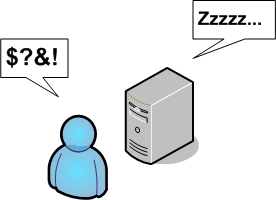Last-Minute Tips to Avoid Holiday Downtime

The holiday season is in full swing, and more than a casual interest should be paid to the looming threat of downtime.
Since retailers and other Web workers are in the midst of their biggest trafficked period, it will pay dividends for website owners to develop a project plan to ensure that no element of their websites have been overlooked. Should you overlook even one part of the infrastructure there is a real risk of downtime occurring. As everyone knows, downtime is bad for business and even your reputation.
Based on the results from the Ponemon Institute downtime costs as much as $5,000 per minute for website owners on average which converts into a staggering $300,000 per hour. Clearly it is important to take all the necessary steps to ensure business continuity. With that in mind, here are tips to ensuring uptime and avoiding the disastrous downtime.
- Start by making arrangements with your telecoms supplier to ensure that you have the required capacity to deal with peaks in traffic. These peaks in traffic could not only be caused by the approach of an important date (e.g. Christmas), but also could be caused by promotions being launched by your company's marketing department in order to generate extra business (e.g. daily deals, social media promotions, etc.).
- Having dealt with the external factors, such as telecommunications and marketing and promotions, it is now time to turn to the actual infrastructure you own or rent from a service provider. Server capacity is important. It is also good practice to spread content across different servers with a series of backup servers that can be made available in the case of primary server failure, overload or even malicious attack. However beefing up your server farm is not the only step that you should take.
- One should consider a load balancers or application delivery controllers (ADCs), as they play a vital role in your website infrastructure. These load balancers have a number of important functions to perform that will both protect your content servers from being overloaded and provide website visitors and customers with a satisfying experience. You can think of the load balancers as traffic cops, constantly monitoring the website traffic as it rises toward its peak and directing this traffic to the best performing content servers, while at the same time limiting new sessions to those that are heavily loaded.
Load Balancers in Focus
Leading load balancers monitor content server health at Layer 4 and performance at Layer 7. This is a vitally important feature in effective load balancing. Layer 4 monitoring will tell your IT department how a server is performing in general and how it is dealing with requests for content from visitors to your website. Layer 7 monitoring directly checks the performance of individual applications, providing a more 3 dimensional view of what is going on. Monitoring at Layer 7 could, for example, show you that your application that displays information about products that are available for purchase is performing well while at the same time your payment portal is being overloaded on the server in question.
An additional useful feature of leading ADCs is their ability to cache content. The load balancers "learn " about the most frequently requested Web page content and maintain this information in cache so that users requirements can be served without the request constantly being passed to the content servers. It is advisable that load balancers are set up in high availability mode (HA) for mission critical content load balancing. This means that should one of the load balancers fail, the other will automatically take over as the second unit constantly monitors the performance of the primary device. With your ADCs installed you can relax and prepare to enjoy the festive season yourself or just rest easier knowing your website wil be available.
About the Author: Chris Heyn is the General Manager of KEMP Technologies Italy. He lives in a small village called Arcene about 40kms from Milan. For the past 14 years Chris has been involved in business development for ICT companies looking to expand their activities into Italy and the eastern Mediterranean as well as the Middle East.








